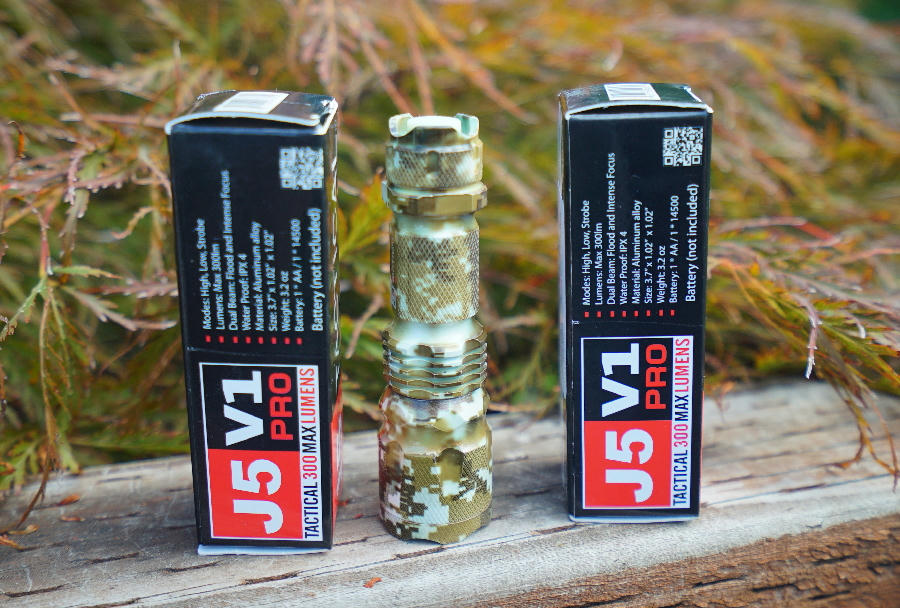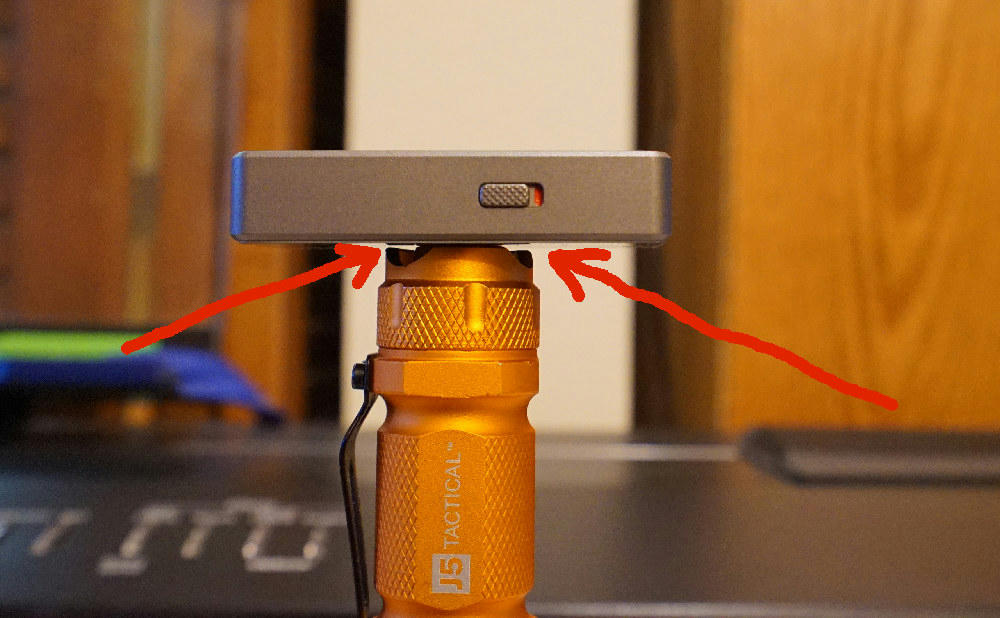Why?
I chose to review the J5 Tactical V1 Pro because no one has previously posted a detailed review on BLF and I was intrigued by its marketing success. There are many positive reviews on Amazon (and outside Amazon). However, what’s missing is the type of technical review we might like to see here on BLF.
The J5 Tactical V1 Pro is the most reviewed flashlight on Amazon, with nineteen thousand reviews (Amazon LINK). EDIT: AMAZON LINK NO LONGER WORKS AND NO LONGER APPEARS TO BE AVAILABLE ON AMAZON. Eighty-four percent of the reviews are either 4 or 5 stars. Certainly, non-flashlight geeks perceive it as a good light. Over one million sold (they claim) by May 2016, according to this article HERE. J5 technical specs from the manufacturer’s website HERE.
This review is free from any influence by the manufacturer.
I purchased three J5’s. This gave me a chance to compare build quality/consistency between lights. This turned out to be very enlightening to say the least (more on that later). Below are my three J5’s (Hunter Orange, Black and Desert Camo). Other colors are available as well.
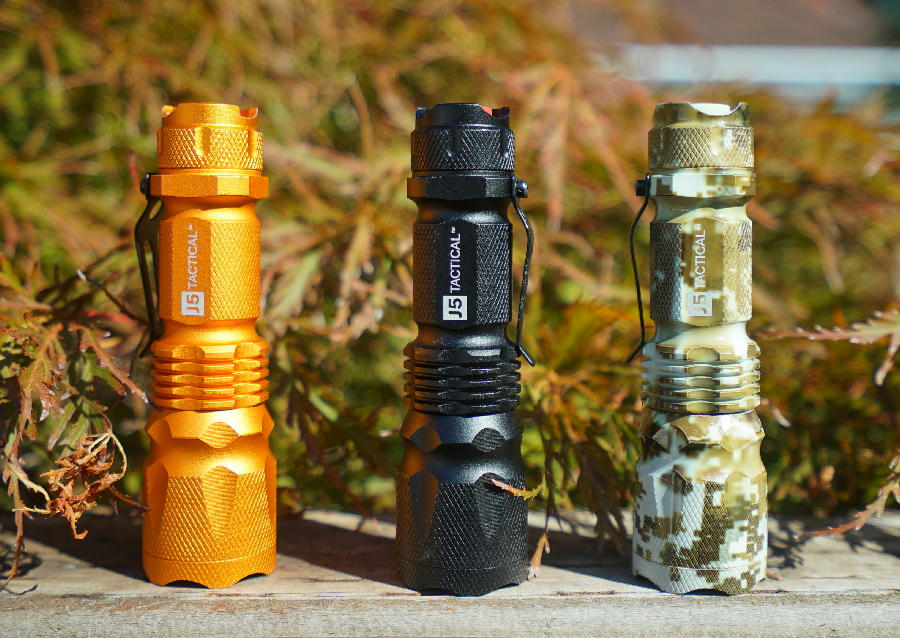
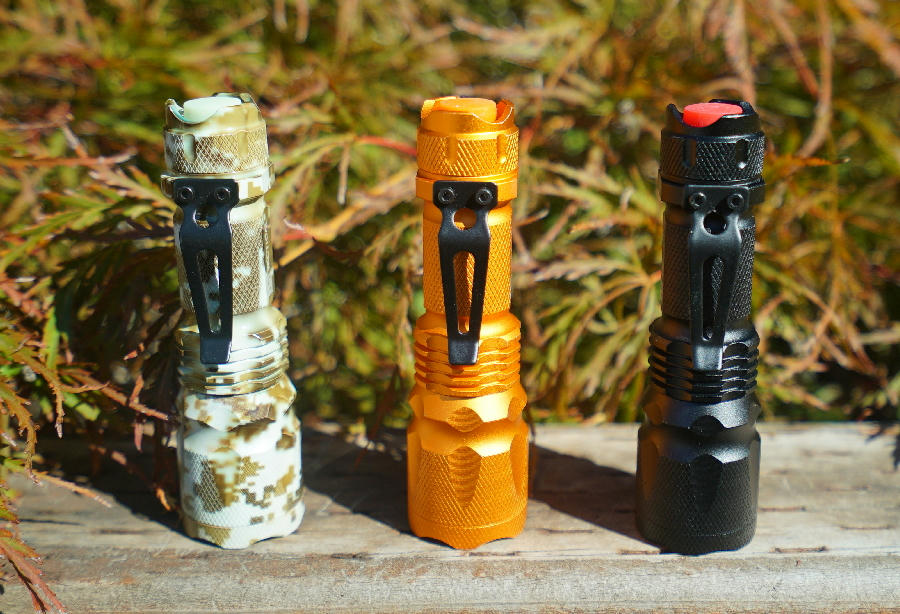
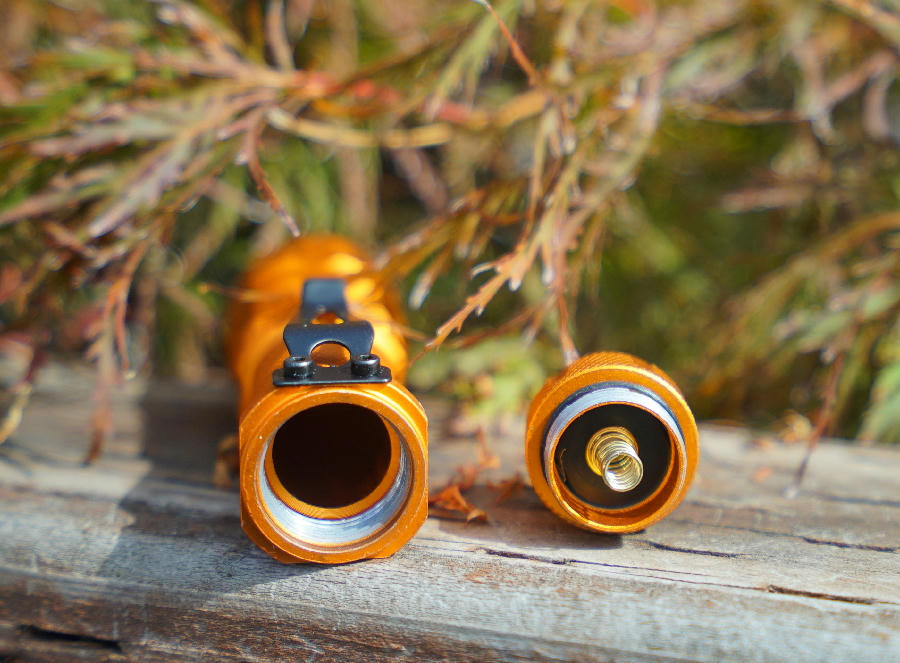
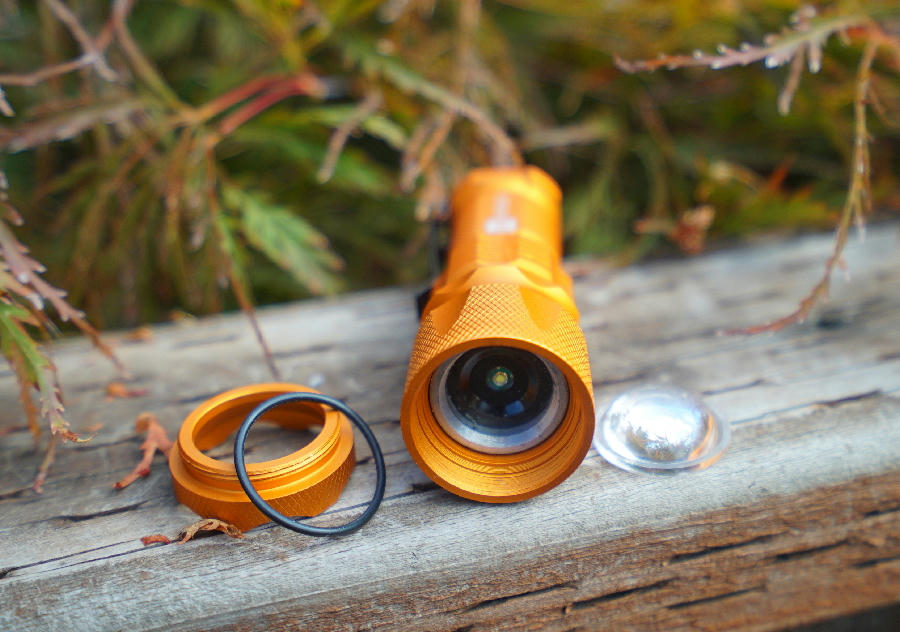
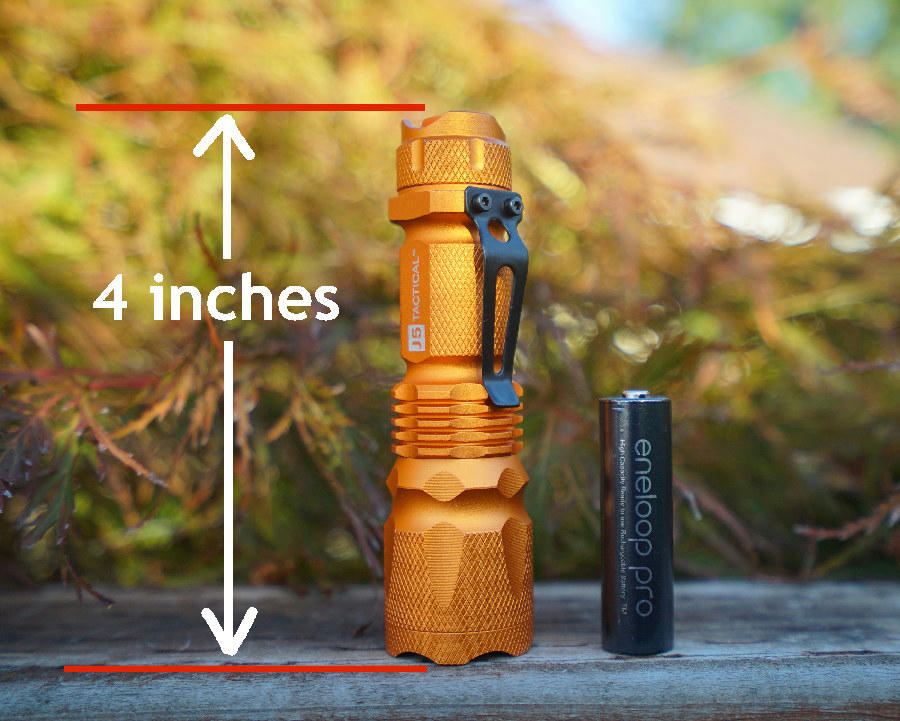
Basics
- Approx $10-14$ (can be bought in packs of three)
- Single AA or 3.7V 14500
- Adjustable focus (their term). Convex lens.
- 3 modes (high, low, strobe). Half press on/off button to cycle modes (no memory mode).
- 300 lumens on high (they claim)
- Available in six different colors and kinda looks like a tactical light.
- “water resistant” (their claim, I could find no actual IPX rating)
- Length - 4 inches
- LED type – unknown (listed as “J5 LED”)
- manual – none
The following will be covered in this review:
- lumens
- runtime graphs (with five different batteries)
- beam pattern
- tint lottery
- PWM
- temperature
- drop test
- water test
- tail stand issue
- slide focus stiffness
- device failure rate
Let’s start with lumens
The manufacturer makes the following claims:
“300 lumens output on high”.
“The brightest flashlight powered by one AA battery”
“The beam can sweep light over the length of two football fields on a clear night”.
To measure lumens, a Texas Ace Calibrated Lumen Tube was used (built by long-time BLF member Texas_Ace). Before taking any measurements, I first performed a calibration check using a sphere calibrated reference light (Convoy S2+) purchased from BLF member maukka. Per the calibration data maukka sent me, the lumens tube accuracy is currently dead-on (as seen below), within a couple of lumens (at 30 sec). The reference S2+ output was measured with a Lisun integrating sphere owned by maukka (this model here). Note that it’s generally accepted by several BLF members that the Texas Ace Calibrated Lumen Tube is accurate to within 5%.
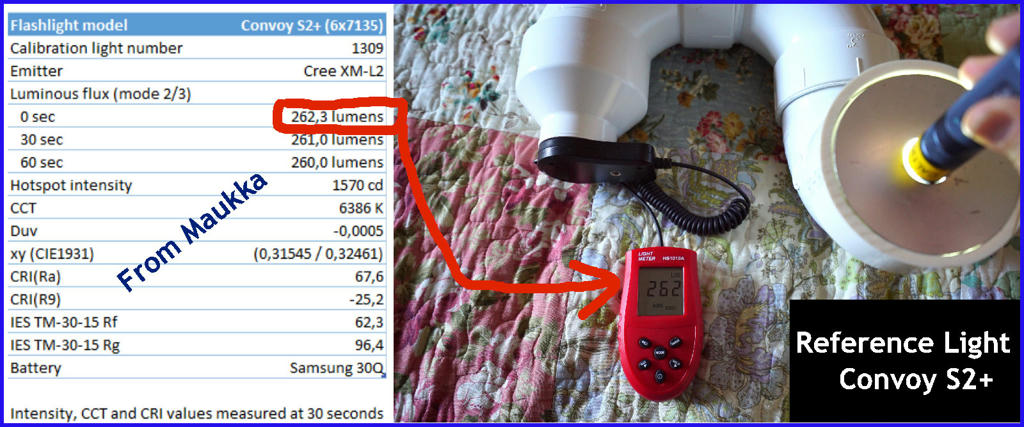
Note the “flood” position produces the highest output. All measurements were taken in the flood position because readings were much lower (by about 45%) in the spot mode.
So, using the Texas Ace Calibrated Lumen Tube, the J5 Desert Camo gives us the following (all measurements taken 30 sec after turn on, per ANSI FL-1):
Fully charged Olight 14500 battery (at 4.2V)
High: 134 (manufacturer spec 300)
Low: 35
Fully charged AA Panasonic Eneloop Pro
High: 53
low: 13
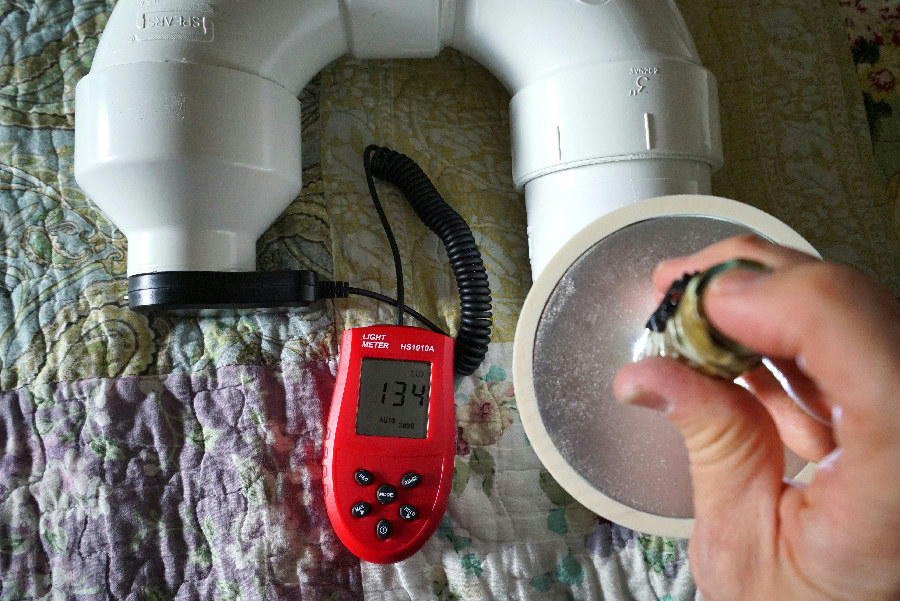
The other two lights (Hunter Orange and Black) gave the following measurements on high (with the same Olight 14500 battery):
Black: 114
Hunter Orange: 126
That’s about a 15% variance in brightness between the three lights.
It’s clear the J5 does not achieve anywhere near the claimed 300 lumens. Given the possible 5% variance of the lumen tube, the best we could hope for on the Desert Camo would be 141 lumens – still less than half the manufacturer’s claim.
Runtime Graphs
Now that we know the approx lumens, we can generate some meaningful runtime graphs. Data for runtime graphs (using five different batteries) was taken with a Reed Instruments SD-1128 data light logger. Data was then graphed using Microsoft Excel.
An Olight 3.7V 14500 was used for the first runtime graph.
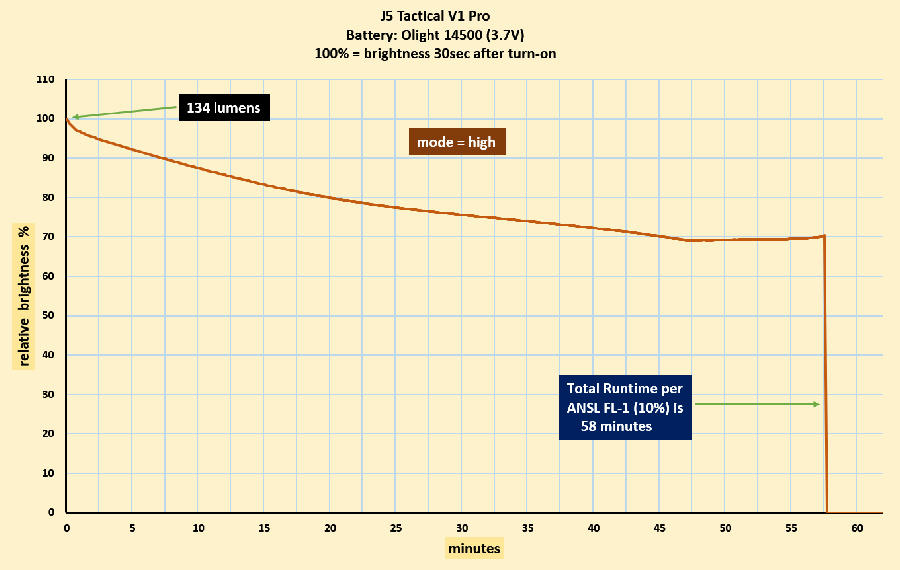
The second battery was an AA Energizer Ultimate Lithium
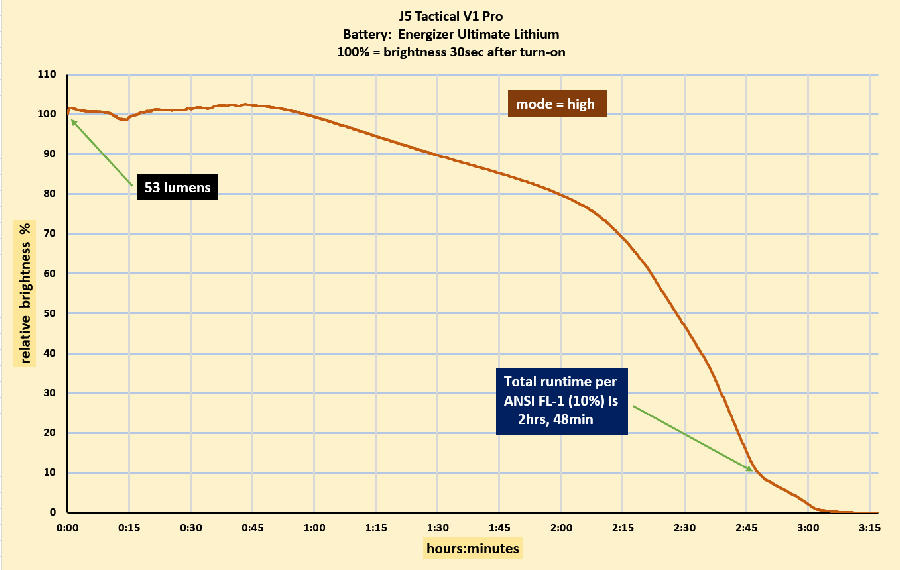
The 3rd battery was an AA Panasonic Eneloop Pro, capacity tested on an XTAR Dragon.

The fourth battery was an AA Energizer Max alkaline
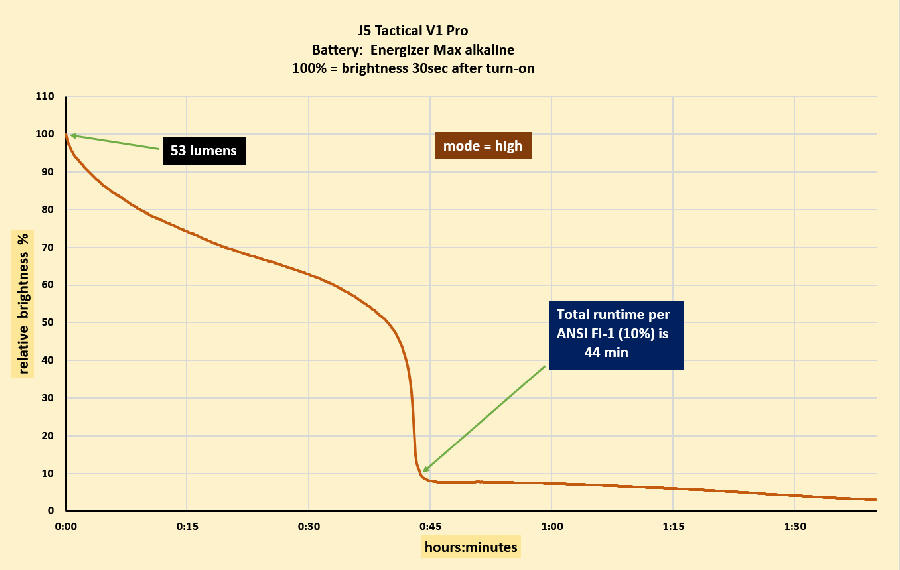
The final battery was an AA Duracell Quantum alkaline
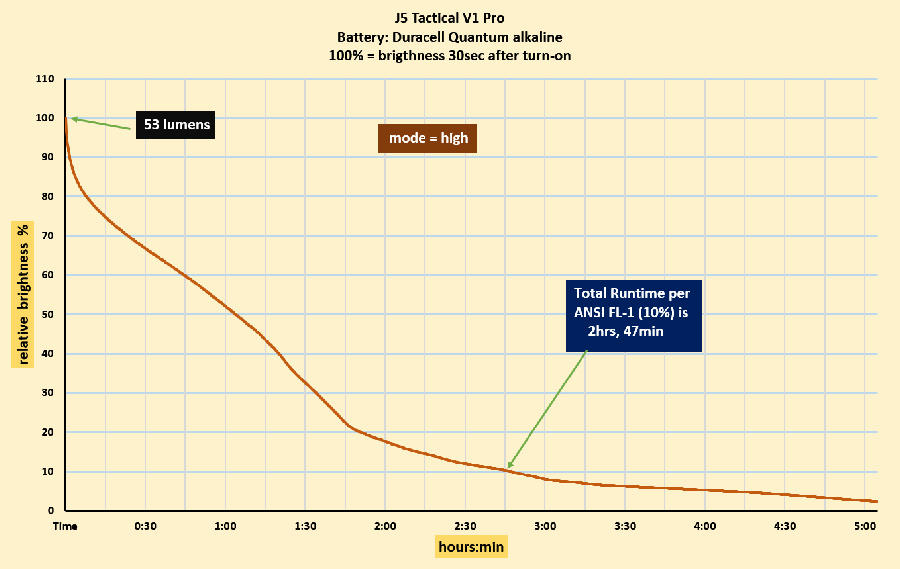
Beam Patterns
The adjustable focus flood position merely produces a larger hot-spot. Outside the hotspot is a dark area, then a colorful corona. Holding the light at about chest height (4ft), pointing straight down, gave a flood pattern of about three feet across, adequate for walking at night – but much less floody than higher-end lights. Here, the light is a couple of feet from a white poster board.
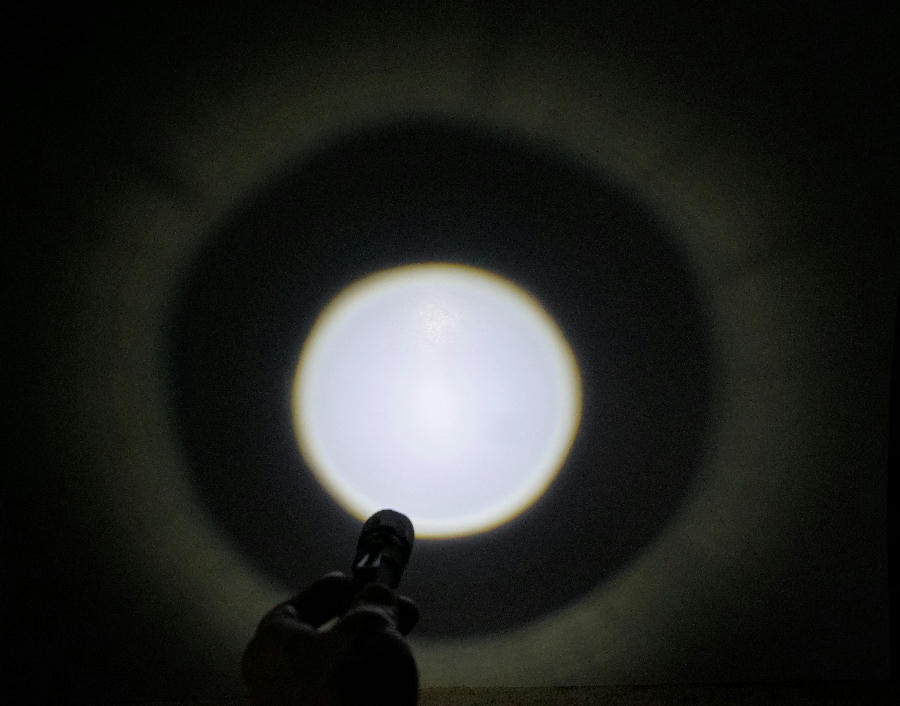
Zooming out to spot mode results in an outline of the LED, with an odd looking outer corona. This is also two feet from a white poster board.
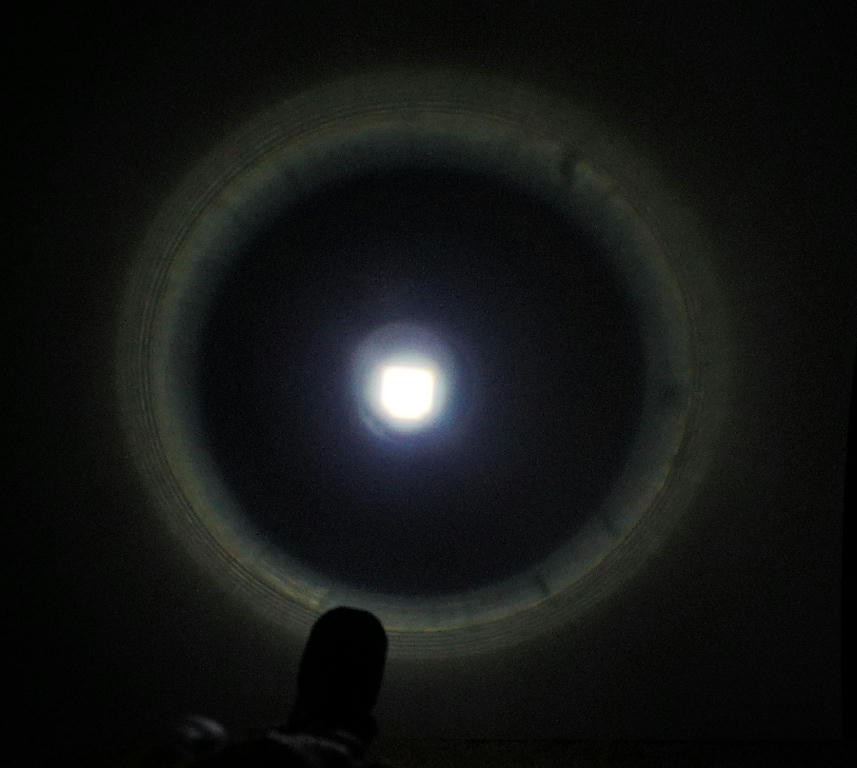
Here (flood mode) the light is about 13ft from the swing:
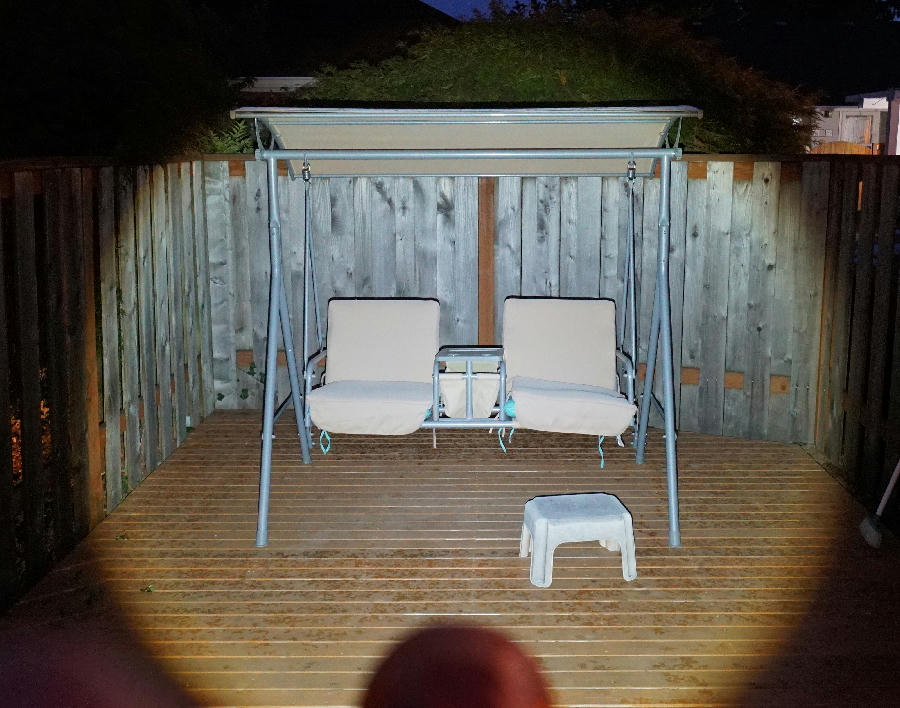
Here, the light is about 5 ft from the tomato plant & kale.
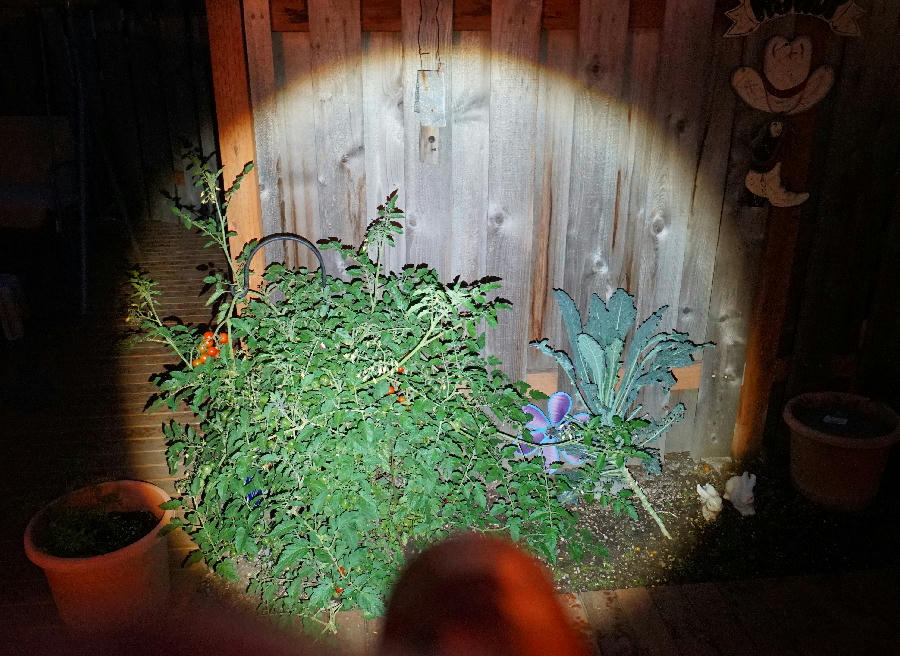
Tint Lottery
Using a white poster board, this photo was taken with a Sony A7S (white balance on “daylight”). Photo looks the same as it did to my eye.
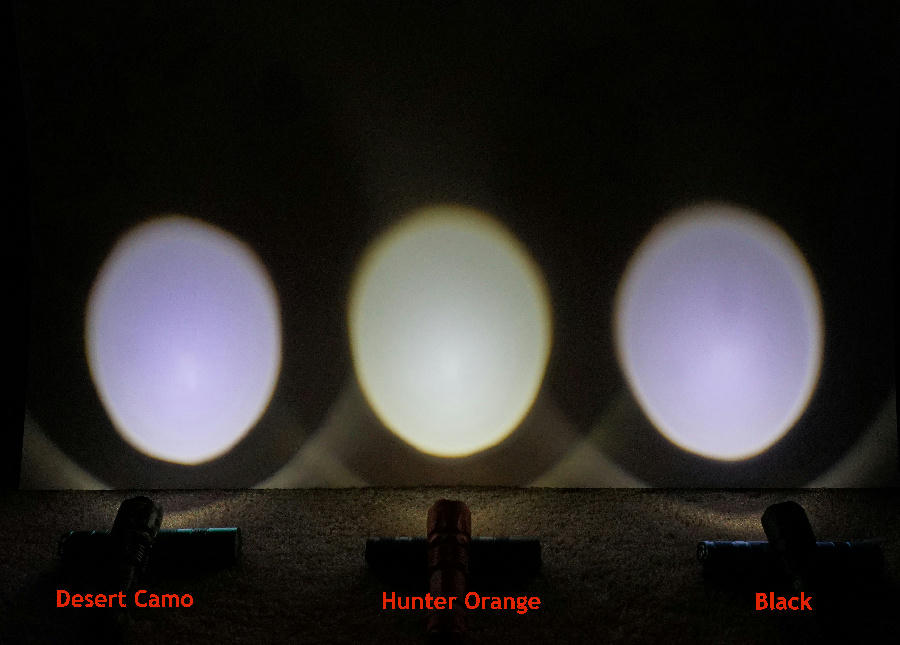
Pulse Width Modulation (PWM)
PWM was checked using an OSRAM BPW34S PIN PhotoDiode and a Rigol scope. No PWM was seen on high (expected). However, there is obvious PWM on low, which measured 239hz (with a 26% duty cycle).
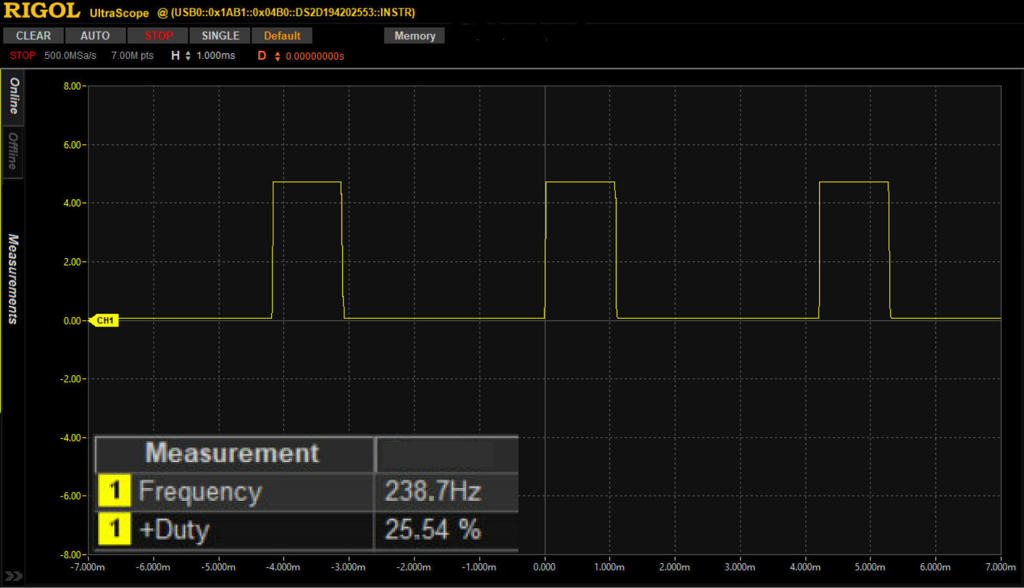
Strobe frequency was approx 8hz.
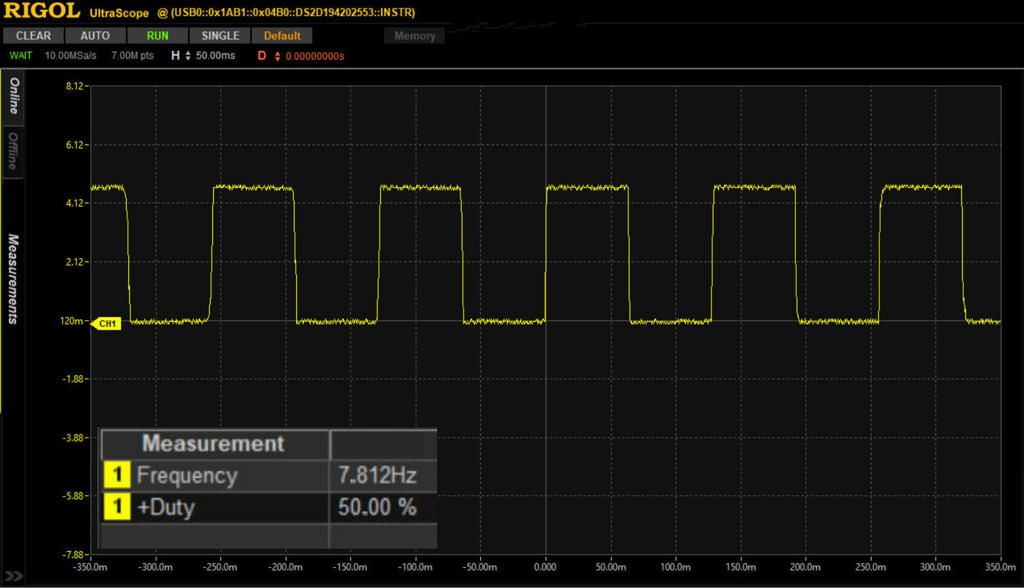
Temperature
Left on high for ten minutes (with a 14500 battery) and no cooling, the J5 reached 115 degrees F, nice and toasty warm, but not too hot to hold. As a reference check, the light measured 75 degrees cold, exactly what our indoor room temperature meter showed at the time – so I’m confident the Fluke is measuring accurately with emissivity set to .95
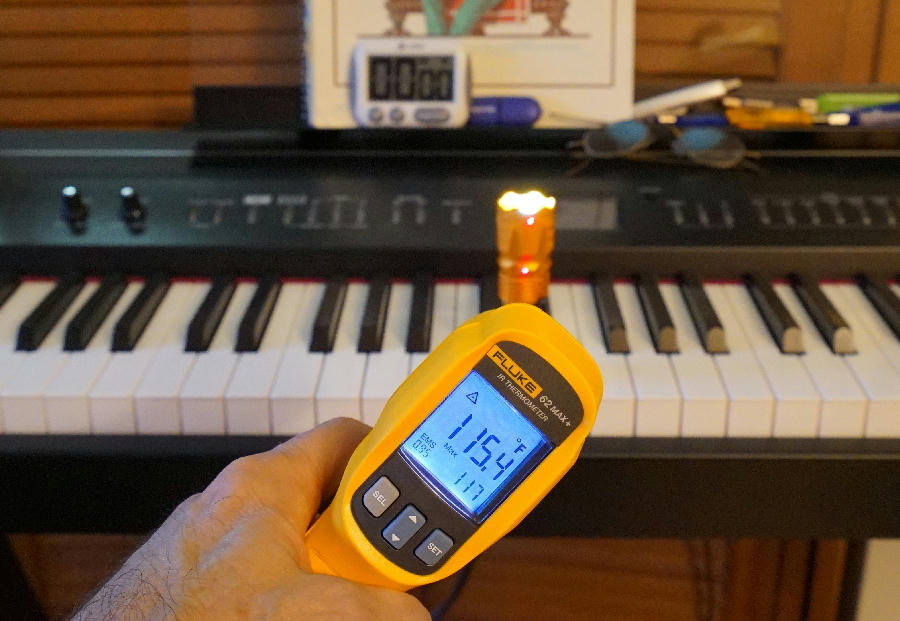
Drop Test
The manufacturer claims “this flashlight can survive a 9-foot drop” (quote from the Amazon listing).
The J5 Desert Camo was taken outside. I then climbed up a small step latter and dropped the J5 at 9ft onto a wooden deck while the light was on. This was done three times. After all three drops, the light appeared to work properly. Two of the drops were with the light in the horizonal position, and the third drop was with the lens down. Their claim appears to be accurate. Other stress tests have been performed by others, like this YouTube video where a truck was driven over the J5.
“Water Resistant”
The manufacture claims the light is “water resistant”, whatever that means. To stress the J5, it was submerged under water for two minutes while turned on. It’s not specifically rated for underwater – but I wanted to see what would happen. After removing the J5, it appeared to work normally. I then let the light run for another fifteen minutes (on a dry table). No issues were detected, although I don’t know how to disassemble the head to inspect for moisture. The light was also turned on several times the following day, everything still appeared normal. This test would suggest that using the J5 in rain would not be a problem.
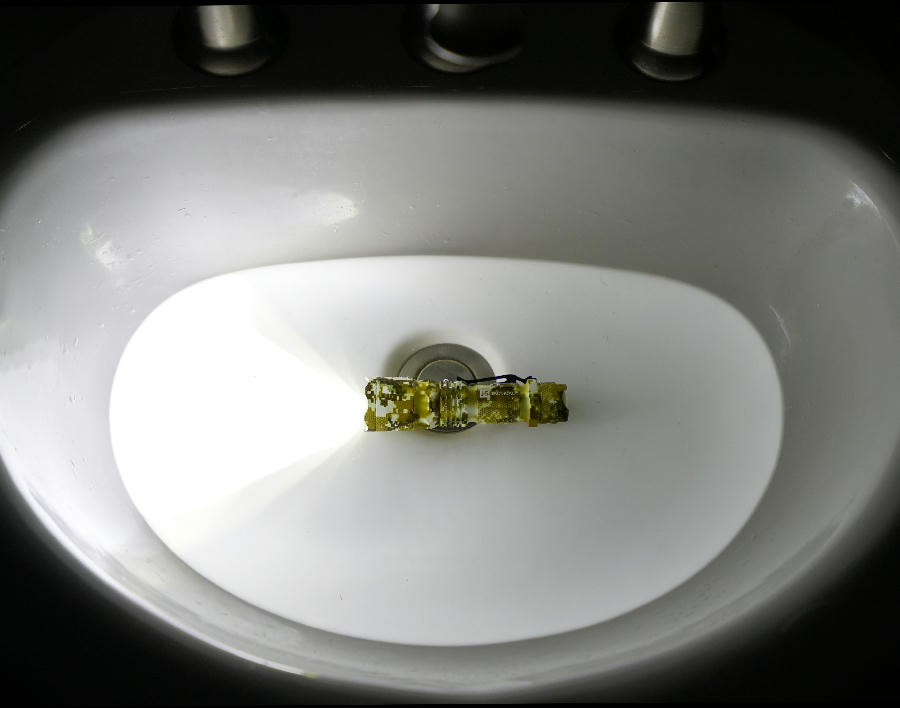
Tail stand issue
You would think that the crowned tail cap would allow the light to tail stand easily. Not so. Two of the lights could tail stand, but were a bit wobbly. However, the Hunter Orange was difficult to tail stand at all. As you can see in the photo, the rubber on/off button on the Hunter Orange is higher than the crowned protrusions. On the other two lights, the on/off button is closer to the same height as the crowns – which makes it easier to tail stand. In this photo, I’m using the flat gorilla glass on an Olight ION to visually look for space between crowns and on/off button. See the problem?
Slide Focus Stiffness
The tightness of the focus mechanism was not consistent. On three of the lights, it was desirably stiff when pulling from flood to spot, which indicates it will not drift in normal use (good). On the fourth light (Desert Camo), the focus mechanism was extremely loose, shaking it even lightly caused the zoom mechanism to move easily. It would be impossible to walk with this light without the focus mechanism constantly falling towards the spot position. This suggests that manufacturing tolerances are rather poor – or maybe a missing O-ring in the slide mechanism?
Device Failure Rate
Of the first three J5’s that were ordered from Amazon, two of them had defects out-of-the-box.
Unit #1: Dead (would not turn on). Basic troubleshooting with a multimeter revealed the tail cap had no continuity. Also, when the tail cap was moved to another light, the problem followed the tail cap.
Unit #2: The light always turned on to strobe. The initial turn-on should always start on high – followed by low, then strobe. Modes are changed by half-pressing the on/off button quickly.
The two defective units were returned to Amazon for a refund and two replacements were ordered. When I received the two replacement lights, one of them was also defective.
Unit #3: When using a 14500 battery, the light always turned on to low (not high as it should). If an AA battery was used, the mode sequence was correct (high/low/strobe). I did not return this one to Amazon because I called J5 technical support (see below), and they sent me a replacement light (I did not have to return the defective light).
So, the total defect rate (three out of five) was 60%. Ouch.
During the process of getting replacement lights, I emailed J5 technical support (three times over two weeks) and received no response. In the emails, I asked if they were aware of the power-on mode sequence problem.
I then called the J5 technical support number (800-991-3872). Surprisingly, a woman answered within a few seconds. I asked if they were aware of the problem with the mode sequence. She said I must have run into a “bad batch”, and confirmed it should always turn on to high. She said the lights were made in China and they had two employees constantly checking stock in their Utah warehouse (their corporate headquarters). I asked if she knew what kind of final test they did on their manufacturing line. She did not know. She offered to replace the defective light (after confirming my Amazon order #) and I agreed. Later I received the replacement J5, giving me a final total of four J5’s.
CONCLUSION:
I’ve opted not to give a pro/con listing – because everyone can make their own conclusions. However, based on my experience, I could not recommend this light to others, due to the plethora of quality issues. I now have three properly working copies, but getting them was needlessly difficult.
.
